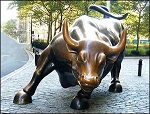Courtesy of Pam Martens
 Two interesting things happened this week just one day apart. On Monday, the Office of the Comptroller of the Currency, the regulator of national banks, released its quarterly report on “Bank Trading and Derivatives Activities” which documented insane levels of risk at four federally-insured banks, which have merged themselves with Wall Street’s trading casinos to form Frankenbanks. The very next day, an opinion columnist at Bloomberg News, Jared Dillian, wrote a column lamenting the “loss of risk-taking” on Wall Street which he appears to blame on “excessive compliance and regulation.” The column was given the pity-party title: “The Wall Street That I Once Knew No Longer Exists.”
Two interesting things happened this week just one day apart. On Monday, the Office of the Comptroller of the Currency, the regulator of national banks, released its quarterly report on “Bank Trading and Derivatives Activities” which documented insane levels of risk at four federally-insured banks, which have merged themselves with Wall Street’s trading casinos to form Frankenbanks. The very next day, an opinion columnist at Bloomberg News, Jared Dillian, wrote a column lamenting the “loss of risk-taking” on Wall Street which he appears to blame on “excessive compliance and regulation.” The column was given the pity-party title: “The Wall Street That I Once Knew No Longer Exists.”
Compare these two very disparate views of the reality on Wall Street today. The OCC’s report shares this:
“The total notional amount of derivative contracts held by banks in the third quarter increased by $978.0 billion (0.5 percent) to $184.5 trillion from the previous quarter…The four banks with the most derivative activity hold 89.3 percent of all bank derivatives….”
So let that sink in for a moment. Four banks, out of the thousands that exist in the U.S., hold 89.3 percent of $184.5 trillion in derivatives – or an unfathomable $164 trillion in the same derivatives that blew up Wall Street in 2008, requiring the largest bailout of Wall Street in U.S. history.
Those four banks are JPMorgan Chase with $52.3 trillion in notional (face amount) derivatives; Goldman Sachs Bank USA with $48.3 trillion in notional derivatives (versus just $387 billion in assets); Citibank with $44.37 trillion in notional derivatives; and Bank of America with $19.6 trillion in notional derivatives.
Citibank’s parent is Citigroup, which blew itself up with derivatives and off-balance-sheet debt in 2008 and became a 99-cent stock in early 2009. It was resuscitated with then secret revolving loans from the Fed totaling a cumulative $2.5 trillion over more than two years according to a subsequent audit conducted by the Government Accountability Office.
…



